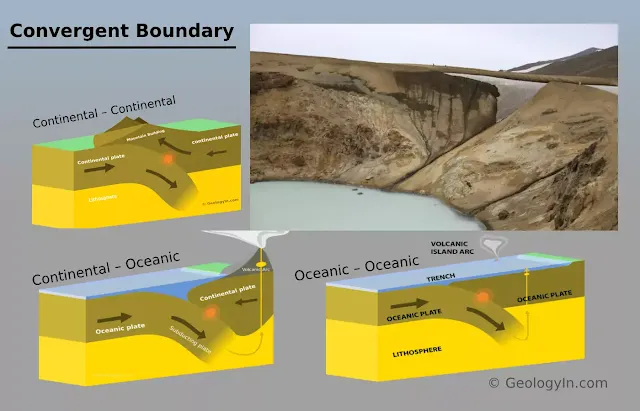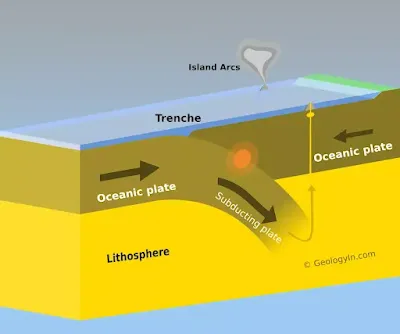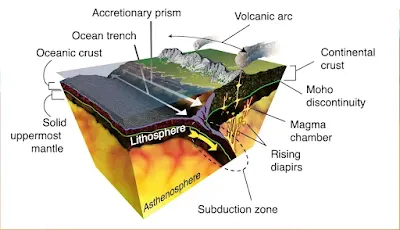Convergent Boundary: Definition, Types, Examples, Features
Convergent plate boundaries, often called destructive plate boundaries, are regions where two or more tectonic plates collide. This collision leads to a variety of dramatic geological events, including earthquakes, volcanic eruptions, and the formation of mountains and deep ocean trenches.
Convergent Boundary
At convergent boundaries, plates move towards each other. Often, one plate slides beneath the other in a process known as subduction. The subducting plate sinks into the Earth's mantle, where intense heat and pressure cause it to melt. This molten rock, or magma, can then rise to the surface, fueling volcanic eruptions. The Cascade Range in the western United States and the Andes Mountains in South America are prime examples of volcanic mountain ranges formed by this process.
When two continental plates collide, the outcome is different. Continental crust is too buoyant to subduct easily. Instead, the immense force of the collision crumples and buckles the crust, pushing it upwards to form towering mountain ranges like the Himalayas.
The immense forces at play at convergent boundaries make them highly active seismic zones. The grinding and shifting of tectonic plates trigger earthquakes, and the vast majority (around 80%) of the world's earthquakes occur along these boundaries. These boundaries are not only destructive but also crucial in shaping Earth's dynamic landscape.
The specific type of convergent boundary, defined by the colliding crusts (oceanic or continental), plays a significant role in the characteristics of the resulting earthquakes and tsunamis.
Convergent Boundaries: Examples & Types
 |
| Convergent Boundary |
Oceanic-Oceanic Convergence
At an oceanic-oceanic convergent boundary, two oceanic plates with distinct densities collide. Due to its greater density, typically associated with older and cooler characteristics, one plate subducts beneath the other. Subduction signifies the descent of a denser oceanic plate into the mantle due to gravitational forces.
The subducting plate encounters elevated temperatures and pressures within the mantle. This extreme environment can induce the breakdown of hydrous minerals trapped within the subducting plate, releasing water. The introduction of water lowers the melting point of the surrounding mantle, facilitating the generation of magma. This buoyant magma ascends through the overriding plate, eventually reaching the surface and erupting to form a linear sequence of volcanic islands, termed a volcanic arc. The Mariana Trench in the western Pacific Ocean and the associated Mariana island chain exemplify this type of convergent boundary.
Key features: Island arcs, deep ocean trenches, active volcanoes.
 |
| Oceanic-Oceanic Convergence |
Oceanic-Continental Convergence
An oceanic-continental convergent boundary is characterized by the collision of a denser oceanic plate with a less dense continental plate. As anticipated, owing to its higher density, the oceanic plate subducts beneath the continental plate. Similar to oceanic-oceanic convergence, the subduction zone generates heat that can cause the subducting plate to melt and trigger the release of water trapped within the minerals.
However, in oceanic-continental convergence, the released water plays a particularly critical role. The rising water vapor can significantly reduce the melting point of the mantle rock above the subduction zone, leading to the generation of even greater volumes of magma. This buoyant magma subsequently rises and erupts, forming a mountain range along the continental margin.
Key features: Accretionary wedge, volcanic arc, mountain ranges, deep ocean trenches on the ocean side.
Accretionary Wedge: As the oceanic plate scrapes against the continental margin, sediments and other debris accumulate, forming a wedge-shaped mass on the continental side.
Volcanic Arc: The subducted plate releases water into the mantle, triggering partial melting and the formation of magma. This magma rises and erupts as volcanoes, forming a chain along the continental margin. The Andes Mountains and the Cascade Range in North America are examples of such volcanic arcs.
Mountain Building: The ongoing subduction and collision over millions of years can lead to the thickening and uplifting of the continental crust, resulting in mountain range formation. The Andes Mountains in South America are a prime example of a mountain range formed by oceanic-continental convergence.
 |
| Oceanic-Continental Convergence |
Continental-Continental Convergence
Continental-continental convergence presents a distinct scenario compared to the previous two. When two continental plates collide, a process of subduction is not feasible due to the relatively low densities of both continental crusts. Consequently, the immense forces exerted during the collision cause the continental crust to crumple and elevate upwards. This large-scale deformation ultimately leads to the formation of colossal mountain ranges.
Key features: Very high mountain ranges, plateaus, extensive faulting and folding.
Mountain Building: The tremendous pressure from the collision pushes the continental masses upwards, leading to the formation of towering mountain ranges. The Himalayas, formed by the collision of the Indian and Eurasian plates, are the world's highest mountain range due to continental-continental convergence.
Plateau Uplift: The collision can also cause extensive areas of continental crust to be uplifted and form high plateaus, like the Tibetan Plateau.
Deformation: The immense forces can cause extensive faulting, folding, and deformation of the continental rocks.
 |
| Continental-Continental Convergence |
Subduction Zones
Subduction zones are a specific type of convergent boundary where one tectonic plate dives beneath another. This subduction is caused by the density differences between the plates. Oceanic crust is denser than continental crust because it is older and cooler. Therefore, when an oceanic plate converges with a continental plate, the oceanic plate will always be subducted beneath the continental plate.
There are three primary types of convergent boundaries, categorized based on the interacting tectonic plate compositions, type of crust (oceanic or continental), that meets at the boundary"
The subduction process creates several geological features:
Oceanic trenches: As the oceanic plate bends downward into the mantle, it forms a deep trench in the ocean floor.
Accretionary wedge: Scraped off sediment and rock from the subducting oceanic plate pile up along the trench, forming a wedge-shaped mass called an accretionary wedge.
Volcanic arc: As the subducted oceanic plate descends into the mantle, it carries water with it. This water lowers the melting point of the mantle rock, causing it to rise as magma. The magma eventually erupts to form a chain of volcanoes on the overriding plate, known as a volcanic arc. The Ring of Fire, a horseshoe-shaped region around the Pacific Ocean, is home to many of Earth's most active volcanoes, all of which are located at subduction zones.
 |
| A diagram illustrating an oceanic-continental convergent boundary, showing the process of subduction and the formation of a deep-sea trench. |
Oceanic Trenches
Oceanic trenches are long, narrow depressions that mark the deepest parts of the ocean floor. They form at convergent boundaries where tectonic plates meet, and one plate subducts beneath the other. The subducting plate, which is usually denser oceanic crust, bends downward into the mantle, creating a deep trench.
Depth: Oceanic trenches can reach incredible depths, with the deepest point being the Challenger Deep in the Mariana Trench, which plunges to 11,034 meters (36,200 ft) below sea level.
Location: Trenches are found along convergent plate boundaries, where tectonic plates collide. They are most commonly found around the Pacific Ocean in a region known as the Ring of Fire.
Convergent Boundaries Examples
Here's a breakdown of each example highlighting the type of convergent boundary and the key features formed:
 |
| Map of convergent boundaries shown as blue lines |
Collision between the Eurasian Plate and the Indian Plate forming the Himalayas: This is a classic example of continental-continental convergence. The immense force of the collision has resulted in the formation of the world's highest mountain range, the Himalayas.
Collision between the Australian Plate and the Pacific Plate forming the Southern Alps in New Zealand: Similar to the Himalayas, this is another example of continental-continental convergence leading to the creation of the Southern Alps.
Subduction of the northern Pacific Plate and the NW North American Plate forming the Aleutian Islands: This is an example of oceanic-oceanic convergence. The subduction of the Pacific Plate beneath the North American Plate has formed the deep trenches and volcanic island arc of the Aleutian Islands.
Subduction of the Nazca Plate beneath the South American Plate to form the Andes: This is a textbook example of oceanic-continental convergence. The subduction of the Nazca Plate has created the deep Peru-Chile Trench on the ocean side and the volcanic Andes Mountains on the continental side.
Subduction of the Pacific Plate beneath the Australian Plate and Tonga Plate, forming the complex New Zealand to New Guinea subduction/transform boundaries: This region showcases a complex tectonic setting with both subduction and transform boundaries. The subduction of the Pacific Plate is responsible for the trenches and volcanic activity in parts of New Zealand.
Collision of the Eurasian Plate and the African Plate formed the Pontic Mountains in Turkey: This is another instance of continental-continental convergence. The collision of these plates has resulted in the formation of the Pontic Mountains.
Subduction of the Pacific Plate beneath the Mariana Plate formed the Mariana Trench: This is an example of oceanic-oceanic convergence. The subduction of the denser Pacific Plate beneath the Mariana Plate has created the deepest oceanic trench on Earth - the Mariana Trench.
Subduction of the Juan de Fuca Plate beneath the North American Plate to form the Cascade Range: This is another example of oceanic-continental convergence. The subduction of the Juan de Fuca Plate has resulted in the formation of the Cascade Range, a chain of volcanoes on the western coast of North America.
These examples showcase the diverse geological features that can be formed at convergent boundaries depending on the type of plates involved and the dynamics of the collision or subduction process.
Conclusion
Convergent boundaries epitomize the intricate interplay of tectonic forces that sculpt the Earth's lithosphere. Through the collision of tectonic plates, these zones engender diverse geological phenomena, ranging from volcanic arcs and mountain ranges to deep oceanic trenches. Appreciating the mechanisms and consequences of plate convergence elucidates fundamental aspects of Earth's dynamic processes, underscored by the pervasive influence of tectonic activity on terrestrial landscapes and seismicity.
Read also:
The Differences between Convergent and Divergent Plate Boundaries
Types of Plate Boundaries
The Terminology of Convergent Plat Boundary
Divergent Boundary: Definition, Features, Examples
What Causes Tectonic Plates to Move

%20(1).webp)






